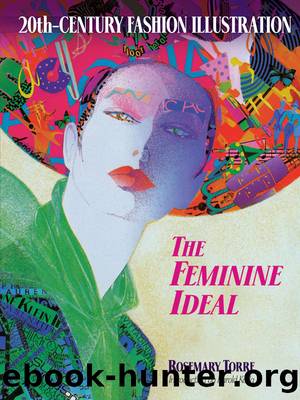20th-Century Fashion Illustration by Rosemary Torre

Author:Rosemary Torre
Language: eng
Format: epub
Publisher: Dover Publications
Published: 2011-01-15T00:00:00+00:00
The cover of Flairâs famous rose issue, dated May 1950, has a diecut opening, through which we see a delicate portrait of the Fifties woman.
The Princess brightens the cocktail hour in a full-skirted late-day dress. Sara Johns deftly renders lace and gives the figure Degas-like grace with a few sweeps of her inked brush.
The most exciting publication to emerge in 1950 was Flair, the creation of Fleur Cowles, wife of publisher Gardner Cowles. The monthly magazine offered âthe best in the arts, literature, fashion, humor, decoration, travel and entertainmentâ in a generous 13â à 10â format. Unlike subscribers to todayâs fashion magazines, purchasers of Flair were continually surprised by the look and contents of the next issue. The magazine was an intellectual and visual feast, with essays by Jean Cocteau and Katherine Ann Porter, drawings by Saul Steinberg, inserted booklets, inset cards of art reproductions; accordion pleated pages, flip-ups, pull-downs, and its famous die-cut covers. And it cost an affordable fifty cents. It featured fashion illustrators René Gruau and Sylvia Braverman, whose tremulously sensitive drawings were set off by Gruauâs bold, graphic style. Obviously, production requirements made the magazine too costly to produce, and Flair lasted only one year, but like a dying swan, had lived in beauty. To find all twelve issues in pristine condition is a collectorâs dream.
In addition to editorial pages, illustrations also embellished advertisements, and many illustrators became identified with particular products: Eric and Bouché with Elizabeth Arden; Kovec with Charles of the Ritz; Tod Draz with Dalton Cashmeres; Sara Johns with Pringles of Scotland sweaters; and Colonna with Gayley and Lord Cottons. René Gruauâs regal white swan could only mean Dior perfume, and his drawings of impeccably gloved hands immediately suggested Crescendoe.
If the women depicted by fashion illustrators in the Thirties and Forties were busy at sports or patriotic duties, those in the Fifties seemed to be doing nothing at all. They existed in undefined space, sometimes shown adjusting a veil or earring, applying perfume, or shopping, usually for jewelry, face powder, or a nosegay at a flower stall. Occasionally they were shown at an art exhibit or a cocktail party in the company of a handsome escort. The cocktail dress, a short evening gown made of luxury fabrics, was essential to the Fifties woman. She wore it to late afternoon parties, where a tinkling piano or Frank Sinatra records accompanied the rattle of cocktail shakers. The Ideal seemed to be leisured, dressed to the nines, and undeniably ladylike. Except for the shocking bikini worn on the Riviera, even her beachwear was demure, though in the hands of Claire McCardell, highly sophisticated. Her head was crowned by toques, pillboxes, or picture hats; her handbag and high-heeled shoes matched; and she was never seen without gloves of appropriate length.
Newspapers also featured a wealth of fashion art. Department stores advertised in the pages of important dailies, each with an unmistakable cachet created by their principal artist. Lord & Taylor had the stamp of Dorothy Hood, Arnold Constable
Download
This site does not store any files on its server. We only index and link to content provided by other sites. Please contact the content providers to delete copyright contents if any and email us, we'll remove relevant links or contents immediately.
| Advertising | Annuals |
| Book Design | Branding & Logo Design |
| Fashion Design | Illustration |
| Science Illustration |
Wonder by R.J. Palacio(7750)
Unlabel: Selling You Without Selling Out by Marc Ecko(2989)
POP by Steven Heller(2888)
Hidden Persuasion: 33 psychological influence techniques in advertising by Marc Andrews & Matthijs van Leeuwen & Rick van Baaren(2788)
The Pixar Touch by David A. Price(2744)
Ogilvy on Advertising by David Ogilvy(2692)
Drawing Cutting Edge Anatomy by Christopher Hart(2684)
Slugfest by Reed Tucker(2422)
The Art of War Visualized by Jessica Hagy(2417)
The Curated Closet by Anuschka Rees(2392)
Stacked Decks by The Rotenberg Collection(2283)
365 Days of Wonder by R.J. Palacio(2247)
The Wardrobe Wakeup by Lois Joy Johnson(2238)
The Code Book by Simon Singh(2217)
Rapid Viz: A New Method for the Rapid Visualization of Ideas by Kurt Hanks & Larry Belliston(2200)
Tell Me More by Kelly Corrigan(2200)
Keep Going by Austin Kleon(2170)
Tattoo Art by Doralba Picerno(2086)
Tokyo Geek's Guide: Manga, Anime, Gaming, Cosplay, Toys, Idols & More - The Ultimate Guide to Japan's Otaku Culture by Simone Gianni(1952)
